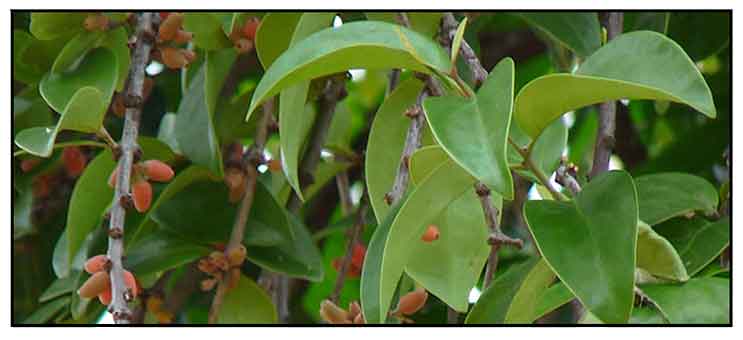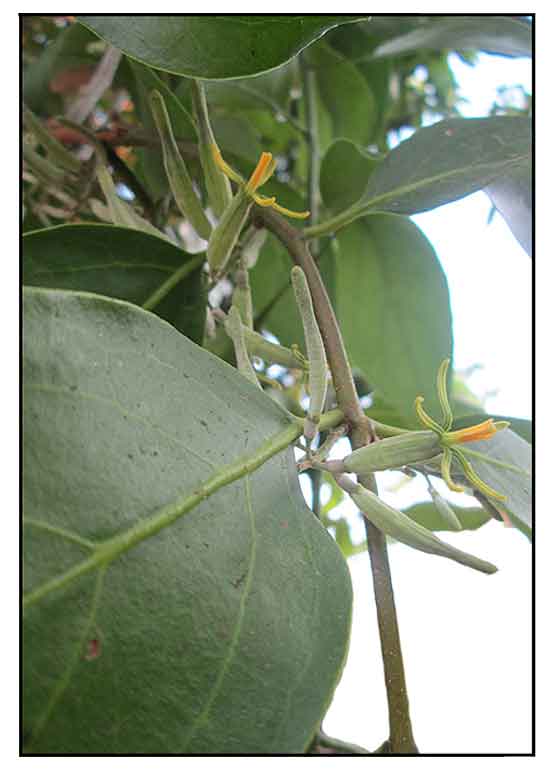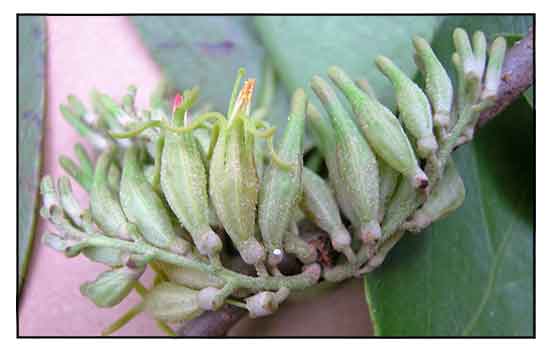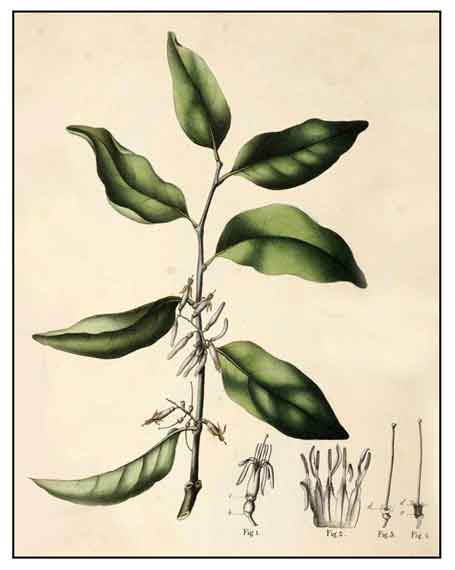 Gen info Gen info
- Dendrophthoe is a genus of hemiparasitic shrubs found in Asia and Australia known as mistletoes.
- It is a parasitic plant found in about 3000 plant species.
- The genus was first described by German naturalist Carl Friedrich Philipp von Martius in 1830.
(10)
- The hemiparasitic shrub serves as food source for moths and butterflies, and often used as landscape plant in parks and gardens.
 Botany Botany
• Agoago is a strong and gray parasitic plant with terete branches. Leaves are rarely opposite, petioled, elliptic-oblong or lanceolate, rarely obovate, 5 to 20 centimeters long, 2.5 to 12 centimeters wide, with a pointed or nearly obtuse apex. Flowers are densely crowded, scurfy, axillary with very short racemes, about 1.5 centimeters long. Bracts are capsular. Calyx tube is cylindrical to urceolate, 1.5 to 2 millimeters long, with a 5-toothed calyx-limb. Corolla is straight, with the tube dilated below and equally 5-cleft at the middle, with linear and pointed lobes. Fruit is oblong-ovoid, 10 millimeters long, 6 millimeters wide.
• Dendrophthoe pentandra is a parasitic, woody shrub that can grow up to 2m in height. Foliage: Simple leaves are arranged alternately along the branches and are lanceolate to elliptic in shape. The leaf blade is thick and leathery, the lateral veins are conspicuous and 2 to 4 pairs can be seen. The leaf blade is approximately 8 to 10cm long. Stems: Stems are grayish and lenticellate. Flowers: Cylindrical flowers are borne on axillary racemes and are bisexual. The corolla is pink or orange and is slightly inflated at the base. The stamens and stigma are extruded. Fruit: Fruit is a red berry which is minutely pilose or glabrous.Â
Distribution
- Native to the Philippines.
-
Found on trees at low and medium altitudes in Zambales Province, Luzon; and in Palawan.
- Also native to Assam, Bangladesh, Borneo, Cambodia, China South-Central, China Southeast, Jawa, Laos, Lesser Sunda Is., Malaya, Myanmar, Nepal, Sumatera, Thailand, Vietnam
 Constituents Constituents
• Stem contains a glucoside, quercitrine.
• Wax, on saponification, yields mellissyl alcohol.
• Leaf extracts yield large amount of quercitrin, besides hydrocarbons and fats.
• Study of EA leaves extracts yielded tannins, saponins, flavonoids, and alkaloids. Crude extract contained 1.33% alkaloid, 2.67% flavonoid, 14.87 µg/g total phenolic acid. Heavy metals were present below maximum permissible levels. (see study below) (11)
• Phytochemical screening of n-hexane fraction revealed presence of flavonoids, and quinones; the alkaline ethyl acetate fraction showed the presence of flavonoids, polyphenols, tannins, and quinones; the water fraction showed the presence of flavonoids, polyphenols, tannins, and Quinones. Calculated total flavonoid as quercetin was 0.068 kg w/w. (see study below) (17)
Properties
• Considered antioxidant, antidiabetic, antihypertensive.
• Studies have suggested antibacterial, antihypertensive, spasmolytic, antioxidant, antidiabetic, anticancer, hepatoprotective, anti-inflammatory, immunomodulatory, antiproliferative, antiapoptotic, antihypertensive, antiviral properties.
Parts
utilized
Leaves.
Uses
Folkloric
• Poultice of pounded leaves used for small sores and ulcers.
• Juice of leaves used for wound healing, skin infection, and cancer.
• In Perak decoction of leaves used after childbirth as protective medicine.
• In Thailand, leaves or infusion of dried whole plant used for hypertension.
• In Indonesia, used for hypertension, diabetes, cough, ulcers, skin infections, post-partum treatments, cancer, ulcers, and small pox.
 Studies Studies
• Antihypertensive:
Study of an aqueous extract of Loranthus pentandrus in 15 Sprague-Dawley rats with induced-hypertension showed an antihypertensive effect. One possible mechanism of its effect was
a negative cardiac chronotropic effect. (1)
• Ileum Contracting / Spasmolytic / Smooth Muscle Contracting Effect:
Leaf Methanol extract fraction showed ileum contracting activity. An ether soluble fraction showed papaverine-like spasmolytic effect.
Subfractionation showed smooth muscle contracting ability.
• Antioxidant / Antidiabetic / α-glucosidase Inhibition / Toxicity Study:
Study using DPPH free radical scavenging assay showed the methanol extract with significant activity. Both methanol and water extracts of D. pentandra leaves showed significant α-glucosidase inhibition activity. All the mistletoe extracts tested showed no toxicity and showed significant antidiabetes activity. Results suggest D. pentandra is a potential source of antidiabetes and antioxidant compounds. (3)
• Antioxidant:
Study of leaf extract of mistletoe (Dendrophthoe pentandra) grown on star fruit (Averrhoa carambola) isolated a flavonol glycoside, quercitrin (quercetrin-3-O-rhamnoside, an active antioxidant with an IC50 value of 5.19 ug mL. (4)
• Chemical and Pharmacologic Study / Leaves:
Study of methanol and water extracts and fractions of leaves yielded hydrocarbons, fats, and a large amount of quercitrin. Some fractions showed hypotensive effects, ileum contracting activity, and papaverine-like spasmolytic effect. (7)
• Mosquito Repellent / Ae. aegypti and Cx. quinquefasciatus / Leaves: Study of Loranthus pentandrus methanol leaf extract showed strong repellent action against Aedes aegypti mosquito with 100% protection at 240 min at 4 and 5 mg/cm2. (8) (9)
• Anticancer Potential / Toxicity Study / Leaves:
Study evaluated the toxicity and cytotoxicity effect of DP ethyl acetate extract of leaves on selected cell lines (HeLa , L929, Glioma, MD-AMB 231, HepG2 and MCF-7) by MTT assay. The LC50 of DPEA was predicted above 1000 ppm. DPEA extract showed antiproliferative activity on MCF-7 and L929 with IC50 of 4.72 and 18.12 µg/mL, respectively. Results showed the plant to be relatively safe, with potential for development as new chemotherapeutic agent. (see constituents above) (11)
• Hepatoprotective / Antidiabetic / Leaves:
Study evaluated the hepatoprotective, antihyperglycemic, and antidiabetic potential of D. pentandra methanolic leaf extract using fixed dose of 400 mg/kbw on alloxan-induced diabetic rats and paracetamol intoxicated rats. Oral administration of ME showed significantly notable oral glucose tolerance in rats. Single dose exhibited significant antidiabetic activity comparable to standard metformin. The extract also showed significant hepatoprotective to paracetamol-intoxicate rats commesurable to standard Silimarin. (12)
• Antiproliferative Towards Human Breast Carcinoma Cells (MCF-7) / Leaves:
Study evaluated various DP leaves extracts for antiproliferative activity towards MCF-7 cells. Control drug was tamoxifen. The crude DP ethyl acetate and methanol extract were most effective against MCF-7 cancer cell lines. While tamoxifen showed toxicity against both cancerous cell lines and non-malignant cell lines, various types of DP extracts showed less toxicity effect towards normal cells. (13)
• Immunomodulatory / Leaves:
Study evaluated leaf extracts of Dendrophthoe pentandra and Potentilla indica for in vitro immunomodulatory activity. MTT colorimetric assay was used to determine the proliferation of mice splenocytes and thymocytes. Pi and Dp produced time- and dose-dependent increase in cell viability and proliferation. After 72 h of treatment, thymocyte proliferation was augmented by 18 and 41% respectively, and splenocyte proliferation increased by 35 and 42% respectively. Results suggest the extracts act as potential immunostimulants and are an alternative source of immuno-modulatory compounds for treatment of human immune-mediated diseases. (14)
• Quercitrin / Antioxidant / Antibacterial / Leaves:
Study evaluated quercitrin, a flavonoid isolated from leaves of D. pentandra. Antioxidant activity of quercitrin by DPPH method showed IC50 of 3.59 ppm. Antibacterial assessment against four bacterial species i.e. S. typhi, Pseudomonas sp., E. coli, and S. aureus showed linear diameter of inhibition zone with applied concentration of quercitrin. (15)
• Flavonoids / Anti-Inflammatory:
Study evaluated the anti-inflammatory activity of fraction of n-hexane, ethyl acetate base, and water from mistletoes D. pentandra against white male Wistar rats. Using method inducers of carrageenan in the rat right foot, the ethyl acetate fraction of acid at dose of 2000 mg/kbw showed best activity with 41.46% inhibition of inflammation. The anti-inflammatory activity was attributed to the quercitrin flavonoid. Results suggest potential for use as adjuvant anti-inflammatory treatment. (see constituents above) (17)
• Inhibition of Inflammation, Proliferation on Colitis-Associated Colon Cancer:
Study evaluated the effect of DP extract (DPE) on levels of IL-22, myeloperoxide (MPO), proliferation and wild-type p53 expression on murine models of colitis associated colon cancer (CAC) using doses of 125, 250, and 500 mg /kbw. Results showed DPE could inhibit colonic epithelial cells proliferation independently through the P53 pathway. (18)
• Short- and Long-Term Toxicity Studies:
Study evaluated the short and long term toxic effects of D. pentandra ethanol extract in mice. Results showed LD50s for acute toxicity at dose of 17.78 and 12.59 g/kg was comparable to dose of 12.45 and 8.81 g/kg in rats. In subchronic toxicity testing with oral administration of 420 mg/kg for 90 days to Wistar rats, values for hemoglobin, hematocrit, leukocytes and erythrocytes index were within range of reference. Histopathological exam showed some abnormalities. Results suggest the ethanol extract with LD50 values was practically non toxic, but is not recommended to long term use. (19)
• Apoptotic Effects in Human Breast Cancer Cell / Modulation of Calcium and Survivin:
Study evaluated the effect of combination of D. pentandra leaves extract (DPE) and doxorubicin in reducing intracellular calcium concentration (iCa2+) and survivin levels while increasing the number of apoptotic cells in MCF-7 breast cancer cell lines. The combination of doxorubicin and DPE significantly reduced the percentage of survivin (p<0.05) and iCa2+ concentration (p<0.05), and significantly increased the number of apoptotic cells (p<0.05). Results suggest the anticancer effect of doxorubicin can be enhanced in combination with DPE. (20)
• Acute Oral Toxicity Study / Leaves:
Study evaluated the acute toxicity of D. pentandra leaf extracts in male and female Wistar rats using OECD 420 guidelines, using doses of 5, 50, 300, and 2,000 mg/kg. Body weight, organ weights, and blood chemical values were unaffected, and liver and kidney tissues did not show signs of inflammation. Results suggest the D. pentandra leaf extracts were safe at doses studied. (21)
• Amelioration of TNBS-Induced Colitis:
Study evaluated the effect of D. pentandra extract on Foxp3 regulatory T cells and inhibition of Th17 cells in Balb/c mice with TNBS (2,4,6-trinitrobenzene sulfonic acid)-induced colitis. The DP extract potently suppressed colon shortening and MPO in mice with induced colitis. Extract significantly decreased severity of TNBS-induced colitis in a dose-dependent manner. the extract attenuated the loss of body weight (p<0.05), ameliorated the disruption of colonic architecture, significantly reduced colonic MPo (myeloperoxidase) (p<0.05), lowered levels of Th17-associated cytokines, and increased the production of Treg-associated cytokines in mesenteric lymph node cells. Results suggest the DP extract has therapeutic potential to ameliorate TNBS-induced colitis evidenced by histological change and inhibition of IL-17 production. (22)
• Antiproliferative on BCR/ABL Positive and Imatinib-Resistant Leukemia Cell Lines:
Study evaluated the anti-proliferative effects of D. pentandra methanol extract on parental K562 and resistant K562R cells. Results showed the DP extract had greater antiproliferative effects towards K562R (IC50 192 µg/mL) compared to K562 (500 µg/mL) cells. At IC50 concentration, K562 showed increase in apoptosis and cell cycle arrest in the G2/M phase. Results showed potent anti-proliferative effect on BCR/ABL positive K562 cells. (23)
• Apoptosis and Cell Cycle Arrest in Human Breast Adenocarcinoma Cells:
Study evaluated the antiproliferative activity of D. pentandra and its mechanism of action in cancer treatment. MTT assay showed inhibition of MCF-7 cells proliferation with IC50 of 10.65 µg/mL. Cytometric analysis showed mechanism of cell death was via MCF-7 arrested cell cycle distribution at G1/S phase and induced apoptosis. Results suggest increase p53 followed by increase of pro-apoptotic Bax and decrease of anti-apoptotic Bcl-2 led to apoptosis. (24)
• Antihypertensive / ACE Inhibition:
Study evaluated the interaction of bioactive compounds from Scurrula atropurpurea and Dendrophthoe pentandra with angiotensin-converting enzyme (ACE) macromolecule via an in-silico route. The prepared compounds exhibited potential bioactive agents for vasodilation, vasoprotective, and cardioprotective applications. The flavonol 3-O-D-glucoside had a harmless LD50. Molecular docking showed the flavonol had lowest binding energy with value of -8.3 kcal/mol-1, suggesting potential inhibitor for ACE. Molecular docking analysis showed the compounds inhibited ACE macromolecule as: flavonol > kaempferol > casticin > quercetin > quercitrin > isoquercitrin. Results suggest both S. atropurpurea and D. pentandra have potential as traditional herbal medicine, especially to treat hypertension. (25)
• Cytotoxic Against T47D Breast Cancer Cells / Leaves:
Study evaluated the cytotoxic effect of leaves extract from samples collected from several locations in Indonesia against T47D and Vero cell lines. Extract from Kalimantan showed IC50 of 287.39 µg/mL, LC50 798.28 µg/mL, and selectivity index 2.77, which means it was toxic to cancer cells but safe for Vero cell lines. (26)
• Hepatoprotective / CCl4-Hepatotoxicity / Leaves: Study evaluated the antioxidant and hepatoprotective effects of aqueous (ADPL), chloroform (CDPL), ethanol (EDPL) and petroleum ether (PLPL) extracts of D. pentandra leaves. EDPL and PDPL extracts showed highest total antioxidant content (TAC) and total flavonoid content (TFC), and potent antioxidant effect with IC50 31.62 and 24.30 µg/mL (DPPH). Hepatoprotective effect was evaluated against CCl4-ineucee liver toxicity in long evans rats. Treatment with extracts significant counter balanced the toxicity induced elevations of AST, ALT, ALP towards normal. (27)
• Antiviral / Newcastle Disease / Quercitin-like Compound / Leaves: Study evaluated the in vitro ability of a flavonoid compounds, namely quercetin-like compounds (QLCs) from crude methanol extract of leaves against field viruses, specifically the Newcastle disease virus (NDV). The QLCs activity was tested in vitro against the NDV in chicken kidney cell culture. Results showed the QLCs from leaves flavonoids of BD have in vitro antiviral bioactivity against NDV at virulence titer of 10-5 Tissue
Culture Infectious Dose 50% (TCID50). QLCs may have potential for development of medical compounds for the treatment of other human or animal viral infections. (28)
• Inhibition of Aging Process in the Immune System / Leaves: Age-associated immune system dysfunction or "immunosenescence" is indicated by increased susceptibility to infections and various chronic diseases, such as hypertension, diabetes, autoimmune diseases, heart disease and atherosclerosis. One of the markers of immunosenescence is a significant drop in CDF28 and reduced proinflammatory cytokine IL-2. Results showed the ethanol extract of leaves exhibited good potential to inhibit the aging process in the immune system, as characterized by an increase in IL-2 levels and the percentage of CD4+DC28+ and CD8+CD28+. (29)
• Molecular Mechanisms on Colorectal Co of Aging Process in the Immune System / Leaves: Study evaluated the active compound profile and the pharmacological and molecular mechanisms on colorectal cancer (CRC) inhibition. LC-MS/MS analysis identified 18 active compounds. Network analysis revealed that quercetin and Phyllanthusiin E modulated the target genes MYC, Caspase 3, Jun proto-oncogene, Mitogen-activated protein kinase 1, B-cell lymphoma 2, Mitogen-activated protein kinase 8, Bcl-2-associated X protein, and Phosphatidylinositol-4,5-bisphosphate 3-kinase catalytic subunit gamma. DP extract may be beneficial for CRC patients by modulating apoptosis, p53 signaling, mitogen-activated protein kinase signaling, Wnt signaling and phosphatidylinositol 3-kinase-protein B signaling pathways. Results suggest potential for DP for further research in developing anti-CRC drugs. (30)
• Combination Paclitaxel and Chitosan on Breast Cancer Cells / Leaves: Study evaluated the effect of combination treatment of paclitaxel and chitosan-Dentrophthoe pentandra leaves extract nanoparticles (NPDP) on MCF-7 breast cancer cells. The combinations of paclitaxel-NPDP significantly inhibited proliferation of cells (p<0.ooe) and its ability to induce G2/M cell cycle arrest (p<0.001). The combination of NPDP nanoparticles could reduce expressions of TUBB3 and MAP4. Study suggests potential sources of new therapy for NPDP. (31)
• Antifungal / Paclitaxel and Chitosan on Breast Cancer Cells / Leaves: Mango parasite plant D. pentandra is a parasitic plant that attaches to the host. Active compounds from the leaves of the mango parasite have been study for antifungal activity. Fractions of D. pentandra were evaluated for antifungal activity and MICs against Candida albicans. N-hexane and ethyl acetate extracts showed zones of inhibition diameter of 12 mm and 10 mm, respectively. Column chromatography of n-hexane fraction yielded two pure compounds with antifungal activity: E1 and EF with inhibition zones of 10 and 12 mm, respectively. (32)
• Inhibition of Immunosenescence / Leaves: Immunosenescence triggers increased morbidity in geriatrics. Study evaluated the effect of mango mistletoes Dendrophthoe pentandra (MM/Dp) towards CD4/CD8 ration. Mango mistletoes leaves 96% ethanol extracts in doses of 150, 300, and 600 mg /kbw were used once daily for 30 days on female mice. Administration of various doses showed strong correlation (r=0.496) with decreasing CD4/DC8 ration MM/DP has potential in inhibiting immuno-senescence evidenced by decreasing percentage of CD4+CD28- and CD8+CD8-, as well as increasing the IL-2 level. (33)
• Effect on Malondialdehyde (MDA) in Hyperglycemic Rats / Leaves: The duku parasite is usually considered a parasite on the duku plant and is often discarded as it it thought to interfere with the growth of the plant. Study evaluated the effect of the duku parasite leaf extract on reduction of MDA in hyperglycemic rats. Oral administration of ethanol extract EEDBD at 100, 200, and 400 mg/kbw reduced MDA levels in hyperglycemic rats. Only the 400 mg/kbw dose showed significant difference with negative control (CMC-Na), with no significant difference with glibenclamide and normal groups. (34)
• Effect on Brain of Hypertensive Rats Treated with Deoxycorticosterone Acetate (DOCA) Salt: Study evaluated the histopathological profile of the brain in hypertensive male Wistar rats (DOCA-Salt) given mango mistletoe methanol extract (MMME) using doses of 50, 100, and 200 mg/kbw. Administration of EMBM to male rats can significantly decrease the number of cell necrosis and can affect the width of the white matter of the brain. The three dose variations did not show significant difference, suggesting the 50 mg/kbw is optimum dose in reducing amount of cell necrosis in white matter of male Wistar rat brain. (35)
Availability
Wild-crafted. |

![]()

